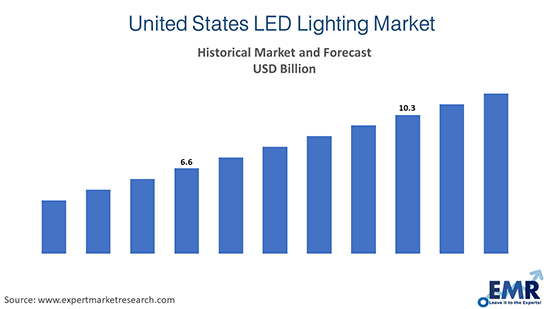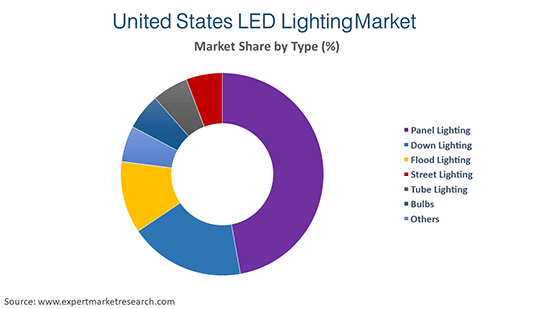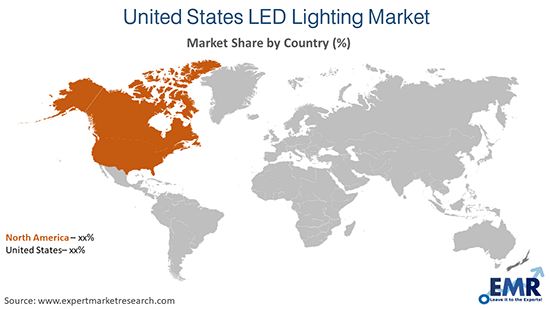Reports
Sale

United States LED Lighting Market Share, Trends, Forecast: By Type: Downlight, Street Light, Bulbs, Tubelights, High Bay, Troffers, Track Lights, Suspended Pendants, Others; By Technology: Smart LED Lighting, Regular LED Lighting; By Application: Indoor, Outdoor; By End Use; Regional Analysis; Competitive Landscape; 2024-2032
United States LED Lighting Market Size
The United States LED lighting market reached a value of USD 11.77 billion in 2023. The market is further estimated to grow at a CAGR of 5.3% during 2024-2032 to reach a value of USD 19.38 billion by 2032.
United States LED Lighting Market Outlook
- The State legislative bodies across the country are determined to phase out the sales of 4-foot linear fluorescents by 2024, which is likely to create greater opportunities for LED products.
- There is a growing preference for LED lighting solutions offering advanced lighting features, such as dynamic beam and colour control.
- The growing trend of indoor agriculture in the region supports the demand for indoor LED lighting solutions.

Read more about this report - REQUEST FREE SAMPLE COPY IN PDF
United States LED Lighting Market Growth Rate
LED lights are a great energy-efficient and long-lasting lighting option that emit less heat and uses up to 90% less energy than incandescent bulbs, while still providing high-quality light output. The United States is witnessing a rapid shift towards energy-saving methods keeping in line with the country’s climate goals. It is anticipated that the majority of the lighting installations in the country would use LED technology by 2035, resulting in energy savings surpassing 569 TWh annually from LED lighting, which is equitable to the energy output of more than 92 1,000 MW power plants per year.
The development of sustainable green buildings in the country is anticipated to strengthen the adoption of LED lighting to reduce energy usage and lower the frequency of replacing the luminaires.
There is a rising demand for ENERGY STAR-rated LED lighting in residential applications as they use nearly 75% less energy and last around 25 times longer than incandescent lighting.
Key Trends and Developments
Favourable government initiatives; increasing adoption in the commercial sector; climate change strategies; and development of smart homes are the key trends impacting the United States LED lighting market growth
Mar 23, 2023
Cree LED released J Series 5050C E Class LEDs, offering the highest efficacy for high-power LEDs in the industry with 228 lumens per watt. The addition of the E Class LEDs expanded Cree LED's portfolio to four performance levels.
Jan 18, 2023
RapidGrow LED, a subsidiary of PANGEA Global Technologies, launched their latest LED light, SOLITE, designed for legal cannabis growers and operators. SOLITE's unique spectrum combines blue light and UV to enhance genetic expression and increase resin production.
Jan 11, 2023
Cree LED released XLamp® Pro9™ LEDs, which deliver up to 15% higher efficacy for 90 and 95 color rendering index (CRI) LEDs. The new Pro9 versions of XLamp LEDs provide 90 CRI light quality with the same efficacy as standard 80 CRI LEDs at 2700-4000K CCT.
Dec 7, 2022
GE Lighting, a Savant company, launched their first-ever line of decorative light fixtures and new pendants, both featuring an integrated LED lighting option. The new line included three decorative fixture families as well as five industrial-style pendant options.
Favourable government initiatives and schemes
The government schemes such as the Solid-State Lighting Program, set out by the US Department of Energy (DOE) have been aiding in fostering the country’s scientific capabilities and leveraging private funds to boost innovation for developing efficient and flexible lighting products such as light-emitting diode (LED) technologies.
Growing application in the commercial sector
In the commercial sector, particularly in agricultural applications, LED lights are becoming a common phenomenon for aiding the growth of plants and minimizing crop loss.
Climate change strategies favouring LED adoption
The phasing out of compact fluorescent lamps (CFLs) by 2025, as part of the central government’s climate change strategy, is anticipated to provide an opportunity for market growth.
Growing penetration of smart home technologies
The adoption of smart home technologies in the USA is driven by the security, flexibility, and convenience offered by them.
United States LED Lighting Market Trends
Installing smart LED bulbs is the easiest method for citizens to begin upgrading homes and provides homeowners with remote control over their electricity consumption. Educational institutes, such as the University of Michigan also uses smart LED lights owing to their extended lifetime and energy efficiency.
There is a rise in the number of high-tech plant factories across the United States adopting indoor farming and LED lights to overcome the loss of crops created due to climate change. LEDs enable the speedy year-round crop cycles in addition to positively impacting the quality and levels of vitamins and antioxidants present in plants.
The Smart Street Lighting NY program launched by the New York government in 2018 aims at replacing at least half of New York's more than 1 million streetlights with sustainable and energy-efficient alternatives, such as LED lighting, by 2025. Further, several programs and incentives provided by utility providers in New York, such as Central Hudson Commercial Lighting Prescriptive Rebates, Con Edison Instant Lighting Incentives and Con Edison Lighting and Controls, among others, are expected to encourage citizens to install and upgrade their traditional lighting to LED lighting.
By 2035, the US is likely to witness a widespread adoption of LED lighting and according to the U.S. Department of Energy, it can result in energy savings of about 569 TWh per year.

Read more about this report - REQUEST FREE SAMPLE COPY IN PDF
United States LED Lighting Industry Segmentation
“United States LED Lighting Market Report and Forecast 2024-2032” offers a detailed analysis of the market based on the following segments:
Market Breakup by Type
- Bulb
- Downlight
- Streetlight
- Tube Lights
- High Bay
- Troffers
- Track Lights
- Suspended Pendants
- Others
Market Breakup by Technology
- Smart LED Lighting
- Regular LED Lighting
Market Breakup by Application
- Indoor
- Outdoor
Market Breakup by End Use
- Residential
- Commercial
- Industrial
- Highway and Roadway
Market Breakup by Region
- New England
- Mideast
- Great Lakes
- Plains
- Southeast
- Southwest
- Rocky Mountain
- Far West
United States LED Lighting Market Share
Based on technology, regular LED lighting is a significant contributor to the market revenue
The regular LED lighting technology is recognised for its exceptional energy efficiency. The minimal heat emission of LEDs and their ability to emit light in a particular direction, eliminating the need for reflectors and diffusers, make them ideal for numerous uses.
Meanwhile, smart LED lighting offers up to 80% savings on conventional lighting and aids in improving the convenience and creativity of users by providing the option to customise the area as per their requirements. In smart LED lighting systems, each light source is linked to a smart system that offers reliable and superior-quality illumination.
Based on application, indoor solutions account for a significant share of the United States LED lighting market
There has been an extensive adoption of LED lighting, such as downlight lamps and luminaries in indoor spaces due to their benefit of sustainability. The rising adoption of home automation technology is anticipated to support the demand for smart LED lighting that can be controlled remotely.
Cities such as Detroit, Los Angeles, and San Jose are replacing traditional street lighting with LED lighting to enhance outdoor safety.
Leading United States LED Lighting Market Manufacturers
The market players are investing in research and development to create innovative lighting solutions integrated with smart technology.
Signify N.V.
Headquartered in the Netherlands, the company is a global leader in lighting for professionals and consumers, and lighting for the internet of things. The company provides 3Dprinted lighting, indoor luminaires, outdoor luminaires, lighting electronics, among others.
ams-OSRAM AG
The company is a global leader in optical solution with specialization in sensing, illumination, and visualization technologies. Headquartered in Austria, the company has a strong R&D infrastructure in over 40 locations supported by a workforce of around 22,000 employees worldwide.
Eaton Corporation plc
Eaton is a power management company headquartered in Ireland. The company is listed on NYSE with the symbol ETN. The company specializes in power management, manufacturing, sustainability, hybrid power, industrial clutches and brakes, e-mobility, and energy transition, among others.
Acuity Brands, Inc.
Acuity Brands, Inc. is engaged in manufacturing and distributing lighting and building management solutions for commercial, institutional, industrial, infrastructure, and residential markets.
Other notable players operating in the United States LED lighting market are SMART Global Holdings, Inc, GE Lighting, Inc., and Hubbell Incorporated., among others.

Read more about this report - REQUEST FREE SAMPLE COPY IN PDF
United States LED Lighting Market Analysis by Region
The city of Boston announced the use of LED fixtures as a replacement for electric lighting to light up the sidewalks. As part of this, it selected Ameresco, Inc to begin auditing and retrofitting of around 80,000 streetlights and other exterior lightings in July 2021. Lesser energy used by LED lights to power the lamps and low maintenance make them suitable for city lighting projects.
Government initiatives such as Energy Efficiency Investment Fund (EEIF) set out by the Department of Natural Resources and Environmental Control (DNREC) offers grants to commercial and industrial customers in the State of Delaware to help them replace ageing, inefficient equipment and systems with energy-efficient substitutes (like LED solutions), enabling businesses to reduce their energy consumption and improve environmental performance.
States such as California and New York are expected to hold major positions in the market owing to their developed infrastructure, technological innovations, and adoption of energy efficiency practices. New York City, in particular, has a highly developed urban infrastructure that includes advanced lighting systems. The city has been implementing LED street lighting to improve energy efficiency and reduce maintenance costs, thus supporting the United States LED lighting market development.
In 2023, as part of the New York state’s Smart Street Lighting NY programme, the New York Power Authority (NYPA) partnered with the Town of Irondequoit to convert 500,00 streetlights to LED technology by the year 2025, supporting the goals of the Climate Leadership and Community Protection Act to lower the electricity demand by three per cent by 2025, which is the most aggressive clean energy law in the nation.
Key Highlights of the Report
| REPORT FEATURES | DETAILS |
| Base Year | 2023 |
| Historical Period | 2018-2023 |
| Forecast Period | 2024-2032 |
| Scope of the Report |
Historical and Forecast Trends, Industry Drivers and Constraints, Historical and Forecast Market Analysis by Segment:
|
| Breakup by Type |
|
| Breakup by Technology |
|
| Breakup by Application |
|
| Breakup by End Use |
|
| Breakup by Region |
|
| Market Dynamics |
|
| Competitive Landscape |
|
| Companies Covered |
|
| Report Price and Purchase Option | Explore our purchase options that are best suited to your resources and industry needs. |
| Delivery Format | Delivered as an attached PDF and Excel through email, with an option of receiving an editable PPT, according to the purchase option. |
Our Top Selling Reports
Warehousing and Storage Market
United States LED Lighting Market Report Snapshots
United States LED Lighting Market Size
United States LED Lighting Market Growth
United States LED Lighting Market Trends
United States LED Lighting Market Share
United States LED Lighting Manufacturers
United States LED Lighting Market Regional Analysis
*While we strive to always give you current and accurate information, the numbers depicted on the website are indicative and may differ from the actual numbers in the main report. At Expert Market Research, we aim to bring you the latest insights and trends in the market. Using our analyses and forecasts, stakeholders can understand the market dynamics, navigate challenges, and capitalize on opportunities to make data-driven strategic decisions.
1 Preface
2 Report Coverage – Key Segmentation and Scope
3 Report Description
3.1 Market Definition and Outlook
3.2 Properties and Applications
3.3 Market Analysis
3.4 Key Players
4 Key Assumptions
5 Executive Summary
5.1 Overview
5.2 Key Drivers
5.3 Key Developments
5.4 Competitive Structure
5.5 Key Industrial Trends
6 Market Snapshot
7 Opportunities and Challenges in the Market
8 Federal Requirements for Lighting Products by State
9 North America LED Lighting Market Analysis
9.1 North America LED Lighting Historical Market (2018-2023)
9.2 North America LED Lighting Market Forecast (2024-2032)
9.3 North America LED Lighting Market by Country
9.3.1 United States
9.3.2 Canada
10 United States LED Lighting Market Analysis
10.1 United States LED Lighting Historical Market (2018-2023)
10.2 United States LED Lighting Market Forecast (2024-2032)
10.3 United States LED Lighting Market by Type
10.3.1 Downlight
10.3.1.1 Historical Trend (2018-2023)
10.3.1.2 Forecast Trend (2024-2032)
10.3.2 Street Light
10.3.2.1 Historical Trend (2018-2023)
10.3.2.2 Forecast Trend (2024-2032)
10.3.3 Bulbs
10.3.3.1 Historical Trend (2018-2023)
10.3.3.2 Forecast Trend (2024-2032)
10.3.4 Tube Lights
10.3.4.1 Historical Trend (2018-2023)
10.3.4.2 Forecast Trend (2024-2032)
10.3.5 High Bay
10.3.5.1 Historical Trend (2018-2023)
10.3.5.2 Forecast Trend (2024-2032)
10.3.6 Troffers
10.3.6.1 Historical Trend (2018-2023)
10.3.6.1 Forecast Trend (2024-2032)
10.3.7 Track Lights
10.3.7.1 Historical Trend (2018-2023)
10.3.7.2 Forecast Trend (2024-2032)
10.3.8 Suspended Pendants
10.3.8.1 Historical Trend (2018-2023)
10.3.8.2 Forecast Trend (2024-2032)
10.3.9 Others
10.4 United States LED Lighting Market by Technology
10.4.1 Smart LED Lighting
10.4.1.1 Historical Trend (2018-2023)
10.4.1.2 Forecast Trend (2024-2032)
10.4.2 Regular LED Lighting
10.4.2.1 Historical Trend (2018-2023)
10.4.2.2 Forecast Trend (2024-2032)
10.5 United States LED Lighting Market by Application
10.5.1 Indoor
10.5.1.1 Historical Trend (2018-2023)
10.5.1.2 Forecast Trend (2024-2032)
10.5.2 Outdoor
10.5.2.1 Historical Trend (2018-2023)
10.5.2.2 Forecast Trend (2024-2032)
10.6 United States LED Lighting Market by End Use
10.6.1 Residential
10.6.1.1 Historical Trend (2018-2023)
10.6.1.2 Forecast Trend (2024-2032)
10.6.2 Commercial
10.6.2.1 Historical Trend (2018-2023)
10.6.2.2 Forecast Trend (2024-2032)
10.6.3 Industrial
10.6.3.1 Historical Trend (2018-2023)
10.6.3.2 Forecast Trend (2024-2032)
10.6.4 Highway and Roadway
10.6.4.1 Historical Trend (2018-2023)
10.6.4.2 Forecast Trend (2024-2032)
10.6.5 Others
10.7 United States LED Lighting Market by Region
10.7.1 New England
10.7.2 Mideast
10.7.3 Great Lakes
10.7.4 Plains
10.7.5 Southeast
10.7.6 Southwest
10.7.7 Rocky Mountain
10.7.8 Far West
11 Regional Analysis
11.1 New England
11.1.1 Historical Trend (2018-2023)
11.1.2 Forecast Trend (2024-2032)
11.2 Mideast
11.2.1 Historical Trend (2018-2023)
11.2.2 Forecast Trend (2024-2032)
11.3 Great Lakes
11.3.1 Historical Trend (2018-2023)
11.3.2 Forecast Trend (2024-2032)
11.4 Plains
11.4.1 Historical Trend (2018-2023)
11.4.2 Forecast Trend (2024-2032)
11.5 Southeast
11.5.1 Historical Trend (2018-2023)
11.5.2 Forecast Trend (2024-2032)
11.6 Southwest
11.6.1 Historical Trend (2018-2023)
11.6.2 Forecast Trend (2024-2032)
11.7 Rocky Mountain
11.7.1 Historical Trend (2018-2023)
11.7.2 Forecast Trend (2024-2032)
11.8 Far West
11.8.1 Historical Trend (2018-2023)
11.8.2 Forecast Trend (2024-2032)
12 Market Dynamics
12.1 SWOT Analysis
12.1.1 Strengths
12.1.2 Weaknesses
12.1.3 Opportunities
12.1.4 Threats
12.2 Porter’s Five Forces Analysis
12.2.1 Supplier’s Power
12.2.2 Buyers Power
12.2.3 Threat of New Entrants
12.2.4 Degree of Rivalry
12.2.5 Threat of Substitutes
12.3 Key Indicators for Demand
12.4 Key Indicators for Price
13 Value Chain Analysis
14 Comparison of LED’s with Conventional Lighting Technologies
15 Competitive Landscape
15.1 Market Structure
15.2 Company Profiles
15.2.1 Signify N.V.
15.2.1.1 Company Overview
15.2.1.2 Product Portfolio
15.2.1.3 Demographic Reach and Achievements
15.2.1.4 Financial Summary
15.2.1.5 Certifications
15.2.2 ams-OSRAM AG
15.2.2.1 Company Overview
15.2.2.2 Product Portfolio
15.2.2.3 Demographic Reach and Achievements
15.2.2.4 Financial Summary
15.2.2.5 Certifications
15.2.3 Eaton Corporation plc
15.2.3.1 Company Overview
15.2.3.2 Product Portfolio
15.2.3.3 Demographic Reach and Achievements
15.2.3.4 Financial Summary
15.2.3.5 Certifications
15.2.4 Acuity Brands, Inc
15.2.4.1 Company Overview
15.2.4.2 Product Portfolio
15.2.4.3 Demographic Reach and Achievements
15.2.4.4 Financial Summary
15.2.4.5 Certifications
15.2.5 SMART Global Holdings, Inc
15.2.5.1 Company Overview
15.2.5.2 Product Portfolio
15.2.5.3 Demographic Reach and Achievements
15.2.5.4 Financial Summary
15.2.5.5 Certifications
15.2.6 GE Lighting, Inc.
15.2.6.1 Company Overview
15.2.6.2 Product Portfolio
15.2.6.3 Demographic Reach and Achievements
15.2.6.4 Financial Summary
15.2.6.5 Certifications
15.2.7 Hubbell Incorporated
15.2.7.1 Company Overview
15.2.7.2 Product Portfolio
15.2.7.3 Demographic Reach and Achievements
15.2.7.4 Financial Summary
15.2.7.5 Certifications
15.2.8 Others
15 New Technology
16 Key Trends and Developments in the Market
List of Key Figures and Tables
1. North America LED Lighting Market (2018-2032)
2. United States LED Lighting Historical Market: Breakup by Type (USD Billion), 2018-2023
3. United States LED Lighting Market Forecast: Breakup by Type (USD Billion), 2024-2032
4. United States LED Lighting Historical Market: Breakup by Technology (USD Billion), 2018-2023
5. United States LED Lighting Market Forecast: Breakup by Technology (USD Billion), 2024-2032
6. United States LED Lighting Historical Market: Breakup by Application (USD Billion), 2018-2023
7. United States LED Lighting Market Forecast: Breakup by Application (USD Billion), 2024-2032
8. United States LED Lighting Historical Market: Breakup by End Use (USD Billion), 2018-2023
9. United States LED Lighting Market Forecast: Breakup by End Use (USD Billion), 2024-2032
10. United States LED Lighting Historical Market: Breakup by Region (USD Billion), 2018-2023
11. United States LED Lighting Market Forecast: Breakup by Region (USD Billion), 2024-2032
12. United States LED Lighting Market Structure
The market reached a value of USD 11.77 billion in 2023.
The market is estimated to grow at a CAGR of 5.3% during 2024-2032.
The market is estimated to witness a healthy growth in the forecast period of 2024-2032 to reach a value of USD 19.38 billion by 2032.
The key types are bulb, downlight, streetlight, tube lights, high bay, troffers, track lights, suspended pendants, and others.
The key regional markets for LED lighting are New England, Mideast, Great Lakes, Plains, Southeast, Southwest, Rocky Mountain, and Far West.
The end uses include residential, commercial, industrial, and highway and roadway.
The key technologies include smart LED lighting and regular LED lighting.
The key players in the market include Signify N.V., ams-OSRAM AG, Eaton Corporation plc, Acuity Brands, Inc, SMART Global Holdings, Inc, GE Lighting, Inc., and Hubbell Incorporated, among others.
Datasheet
-
Selected Sections, One User
-
Printing Not Allowed
-
Email Delivery in PDF
-
Free Limited Customisation -
Post Sales Analyst Support -
50% Discount on Next Update
Single User License
-
All Sections, One User
-
One Print Allowed
-
Email Delivery in PDF
-
Free Limited Customisation -
Post Sales Analyst Support -
50% Discount on Next Update

Five User License
-
All Sections, Five Users
-
Five Prints Allowed
-
Email Delivery in PDF
-
Free Limited Customisation
-
Post Sales Analyst Support
-
50% Discount on Next Update
Corporate License
-
All Sections, Unlimited Users
-
Unlimited Prints Allowed
-
Email Delivery in PDF + Excel
-
Free Limited Customisation
-
Post Sales Analyst Support
-
50% Discount on Next Update
Any Question? Speak With An Analyst
View A Sample
Did You Miss Anything, Ask Now
Right People
We are technically excellent, strategic, practical, experienced and efficient; our analysts are hand-picked based on having the right attributes to work successfully and execute projects based on your expectations.
Right Methodology
We leverage our cutting-edge technology, our access to trusted databases, and our knowledge of the current models used in the market to deliver you research solutions that are tailored to your needs and put you ahead of the curve.
Right Price
We deliver in-depth and superior quality research in prices that are reasonable, unmatchable, and shows our understanding of your resource structure. We, additionally, offer attractive discounts on our upcoming reports.
Right Support
Our team of expert analysts are at your beck and call to deliver you optimum results that are customised to meet your precise needs within the specified timeframe and help you form a better understanding of the industry.


